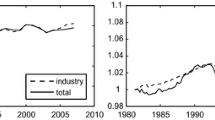Abstract
Our aim in this paper is threefold. First, to test the robustness of the relation between total factor productivity growth and inflation to the specification of the estimating model; second, to test the stability of their relationship in the short run and in the long run, and third, to investigate the direction of causality between these two variables. To accomplish the first objective, we estimate a generalized Box–Cox cost function using data from the two-digit Standard Industrial Classification of manufacturing industries in Greece during the period 1964–1980. The results show that: (a) the acceleration of inflation from 1964–1972 to 1973–1980 reduced total factor productivity growth in a way that was both statistically significant and sizeable, and (b) even when the effect of inflation is separated from the effects of technical change and economies of scale, the choice of functional form is most crucial. With respect to the second objective, somewhat to our surprise, we find that the inflation-productivity trade-off prevails even in the long run. And, finally, regarding the third objective, it emerges that in the great majority of two-digit manufacturing industries the causality runs from inflation to productivity. On these grounds we conclude that for a precise estimation of the relationship under consideration it is imperative to sort out the three effects involved, do so by adopting the most general flexible functional form for the cost function, and run the appropriate stability and causality tests.
Similar content being viewed by others
Notes
See also Diewert (1971).
In addition to the time trend and the constant, the set of instrumental variables included: the number of establishments, the average annual employment, the numbers of working proprietors, salaried employees and wage earners, the gross value of production, the amounts paid in salaries and wages, and the values of gross investment in machinery, buildings and transport equipment.
The results of the tests based on the Eqs. (25), (27), and (29) at the two-digit Standard Industrial Classification of Greek manufacturing industries over the 1988–2004 period are available on request from the authors.
References
Amemiya T (1977) The maximum likelihood and the nonlinear three-stage-least-squares estimator in the general nonlinear simultaneous system. Econometrica 45:955–968
Appelbaum E (1979) On the choice of functional forms. Int Econ Rev 20:449–458
Baltagi BH, Griffin JM (1988) A general index of technical change. J Politic Econ 96(1):20–41
Barro R (1991) Inflation and economic growth. Bank England Econ Bull 1–11
Berndt ER, Khaled MS (1979) Parametric productivity measurement and choice among flexible functional forms. J Politic Econ 81:1220–1245
Bitros GC, Panas EE (1998) Is there an inflation-productivity trade off? Some evidence from the manufacturing sector in Greece. Appl Econ 33:1961–1969
Buck AJ, Fitzroy F (1988) Inflation and productivity growth in the Federal Republic of Germany. J Post Keynes Econ X(3):428–444
Christensen LR, Jorgenson DW, Lau LJ (1975) Transcendental logarithmic utility functions. Am Econ Rev 65:367–383
Christensen LR, Jorgenson DW, Lau LJ (1973) Transcendental logarithmic production frontiers. Rev Econ Stat 55:28–45
Christensen LR, Jorgenson DW, Lau LJ (1971) Conjugate duality and the transcendental logarithmic production function. Econometrica 39:255–256
Clark TE (1997) Cross-country evidence on long run growth and inflation. Econ Inquir xxxv:70–81
Cozier B, Selody J (1992) Inflation and macroeconomic performance: Some cross-country evidence. Working Paper 92-6, Bank of Canada
Denny M, Fuss M, Waverman L (1981) The measurement and interpretation of total factor productivity in regulated industries with an application to Canadian telecommunication. In: TG Cowing, RE Stevenson (eds). Productivity measurement in regulated industries. Academic Press, New York
Diewert WE (1974) Applications of duality theory. In: Intrilligator MD, Kendrick DA (eds). Frontiers of quantitative economics. North-Holland, Amsterdam
Diewert WE (1971) An application of the Shephard duality theorem: Generalized Leontief production function. J Politic Econ 70:481–501
Enders W (1995) Applied econometric time series. J. Wiley and Sons, New York
Fischer S (1993) The role of macroeconomic factors in growth. National Bureau of Economic Research, Working Paper 4565
Gallant AR (1977) Three-stage-least-squares estimators for a system of simultaneous nonlinear implicit equations. J Economet 5:71–88
Granger CWJ (1988) Some recent developments in a concept of causality. J Economet 38:199–211
Grimes A (1991) The effects of inflation on growth: some international evidence. Weltwirtschftliches Archiv 127:631–644
Hanoch G (1975) The elasticity of scale and the shape of average costs. Am Econ Rev 65:492–497
Hurwicz L (1971). On the problem of integrability of demand functions. In: Chipman J (eds). Preferences, utility and demand. Harcourt Brace, New York
Hurwicz L, Uzawa H (1971). On the integrability of demand functions. In: Chipman J. (eds). Preferences, utilities and demand. Harcourt Brace, New York
Kintis A (1986) Estimates of capital stock and capital utilisation rate. Centre of Economic Research, Athens University of Economics and Business, Mimeo
Levine R, Renelt D (1992) A sensitivity analysis of cross-country growth regressions. Am Econ Rev 82: 942–963
Motley B (1998) Growth and inflation: A cross-country study. Econ Rev 1, Federal Reserve Bank of San Francisco, pp 15–28
Smyth DJ (1995) The supply side effects of Inflation in the United States: Evidence from multifactor productivity. Appl Econ Lett 2:482–483
Spitzer A (1982) A primer on Box-Cox Estimation. Rev Econ Stati 64:307–313
Varian A (1978) Microeconomic analysis. Norton and Company, New York
Acknowledgements
We like to thank the editor and an anonymous referee for their constructive comments regarding the issue of causality between inflation and productivity.
Author information
Authors and Affiliations
Corresponding author
Rights and permissions
About this article
Cite this article
Bitros, G.C., Panas, E.E. The inflation-productivity trade-off revisited. J Prod Anal 26, 51–65 (2006). https://doi.org/10.1007/s11123-006-0005-7
Published:
Issue Date:
DOI: https://doi.org/10.1007/s11123-006-0005-7
Keywords
- Inflation
- Productivity Scale economies
- Technical change
- Generalized Box-Cox cost function
- Stability
- Causality




